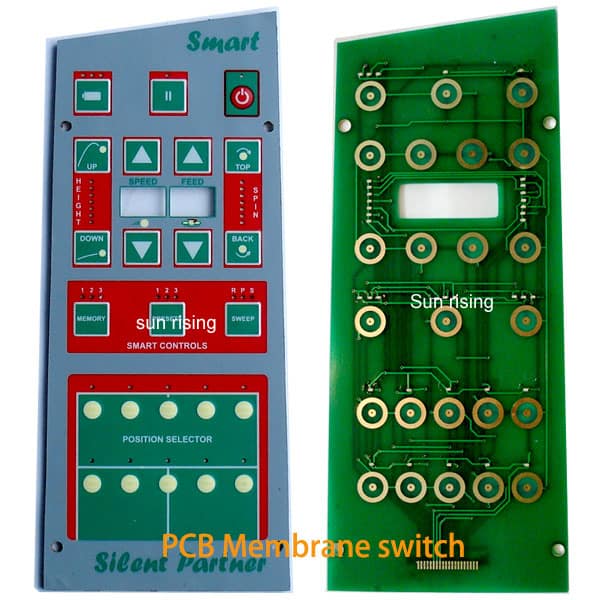How Membrane Switches Improve User Experience in Consumer Electronics
How Membrane Switches Improve User Experience in Consumer Electronics
Blog Article
Why Membrane Layer Switches Over Are Crucial for Sturdy Control Solution
Membrane layer buttons play a critical duty in ensuring the sturdiness and dependability of control systems throughout different sectors. Their distinct construction permits them to endure challenging environmental aspects such as humidity, temperature extremes, and physical wear. This strength not only prolongs the lifespan of the systems they offer but likewise decreases maintenance requirements. As we discover the complex benefits of membrane layer switches, it becomes obvious that their significance goes beyond plain capability, affecting customer experience and operational efficiency. What additional effects do these attributes hold for the future of control system style?
Summary of Membrane Buttons
Membrane layer switches are versatile and dependable elements typically utilized in different digital control systems. These switches consist of a number of layers, consisting of a visuals overlay, a spacer layer, and a printed circuit layer. The graphic overlay provides both functional and visual style, while the spacer layer makes sure that the buttons are triggered just when pressed. The published circuit layer has conductive traces that finish an electric circuit when the membrane layer is pushed, making it possible for the gadget to react to individual inputs.
Membrane buttons are often favored in applications needing a compact and light-weight layout, making them optimal for handheld tools, clinical tools, and commercial machinery. They can be tailored to meet particular individual needs and can include various attributes such as backlighting, responsive comments, and multiple colors. Membrane layer buttons are immune to dirt, wetness, and contaminants, making them suitable for environments where resilience is essential.
Advantages of Resilience
In lots of applications, the toughness of membrane changes deals considerable advantages that boost their general efficiency and dependability. These buttons are made to endure severe settings, making them optimal for use in demanding conditions such as high moisture, extreme temperature levels, and exposure to chemicals. Their robust construction aids to stop damages from physical effect, making sure durable performance and lessening the need for constant substitutes.
Additionally, membrane layer switches are resistant to deterioration, which is crucial in applications where constant communication takes place. This resilience converts to decrease maintenance costs, as organizations take advantage of decreased downtime and less service disruptions. The encapsulated design of membrane switches over safeguards interior parts from dust and moisture access, more adding to their life-span (membrane switch).
Another advantage is their capability to keep constant performance over time. With a high tolerance for mechanical stress and anxiety, these buttons preserve their tactile comments and electric honesty, making certain customer contentment. Eventually, the longevity of membrane layer switches not just enhances operational efficiency yet also cultivates confidence in their dependability, making them a preferred selection for control systems throughout different fields.
Applications in Numerous Industries
Long lasting control systems employing membrane switches find extensive applications across a variety of sectors, each profiting from the distinct qualities these switches use. In the clinical market, membrane layer buttons are important for tools such as person screens and diagnostic tools, where reliability and ease of cleansing are paramount. Their resistance to wetness and pollutants guarantees they keep functionality in sterilized settings.
The vehicle sector leverages membrane switches for dashboard controls and infotainment systems, where they give sleek, low-profile interfaces that boost individual experience. These switches are also designed to endure severe problems, consisting of direct exposure to severe temperature levels and resonances.
In commercial settings, membrane layer buttons are commonly used in equipment control board, supplying responsive responses and toughness necessary for high-usage applications. Their capacity to stand up to chemicals makes them suitable for manufacturing settings where spills and pollutants are constant.

Consumer electronics, such as kitchen home appliances and remotes, also make use of membrane buttons for their convenience and cost-effectiveness. In general, the check my site adaptability and durable nature of membrane layer switches over make them important throughout different fields, ensuring effective operation and durability in control systems.
Style and Aesthetic Allure
While performance is extremely important, the design and visual appeal of control systems geared up with membrane layer switches play a crucial role in customer engagement and overall experience (membrane switch). The aesthetic design of these buttons can significantly influence user perception and communication. A well-designed membrane layer button improves the attractiveness of the device, making it much more enticing to individuals and fostering a link in between the user and the product
Membrane layer switches supply a large amount of adaptability in style, allowing makers to customize graphics, shades, and appearances to line up with brand name identification and item appearances. The use of vivid shades and unique patterns can draw focus, while responsive responses can strengthen the individual's interaction with the device. Additionally, the ability to integrate LED indicators and backlighting into the membrane button design gives both functional and aesthetic advantages, improving exposure and use in numerous settings.

Enhancing Individual Experience

In addition, membrane layer switches can be tailored to incorporate visual user interfaces, improving usability by providing details in a clear and intuitive manner (membrane switch). This customization can consist of icons, labels, and have a peek here shade coding that guide individuals via facility capabilities with convenience. Additionally, their versatility permits assimilation in different environments, ensuring constant performance whether in industrial equipment or customer electronics
The durability of membrane switches also plays an important duty in user experience. By enduring you can try these out harsh problems and extended usage, these switches reduce the possibility of system failings, thus advertising reliability and individual self-confidence. Ultimately, the tactical usage of membrane layer switches not only elevates capability yet also significantly enhances customer interaction with control systems, making them an indispensable part in contemporary design.
Verdict

Report this page